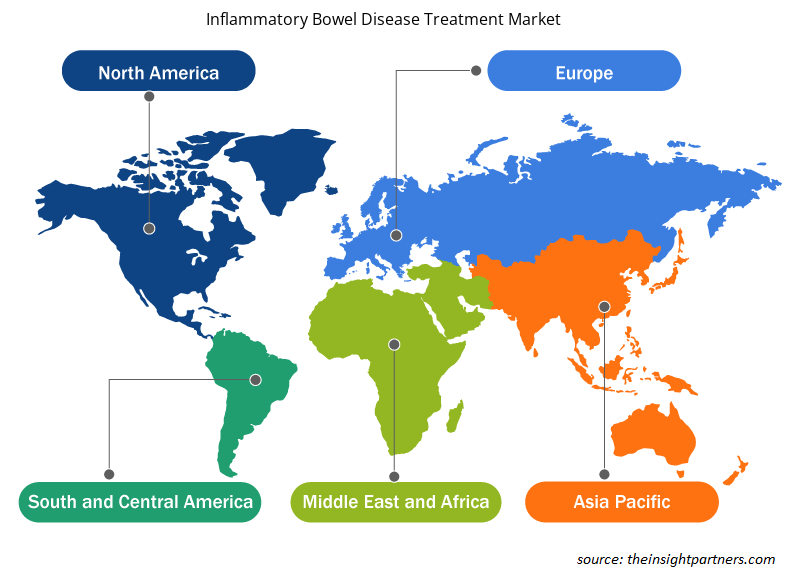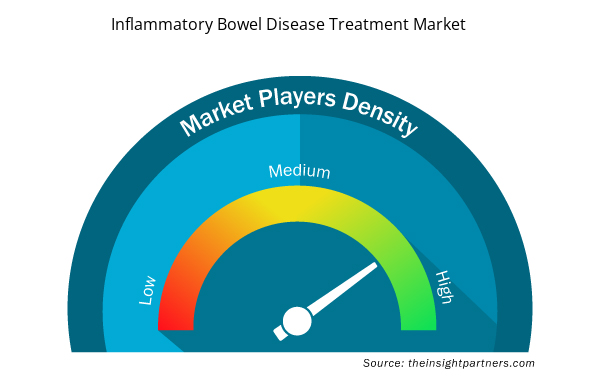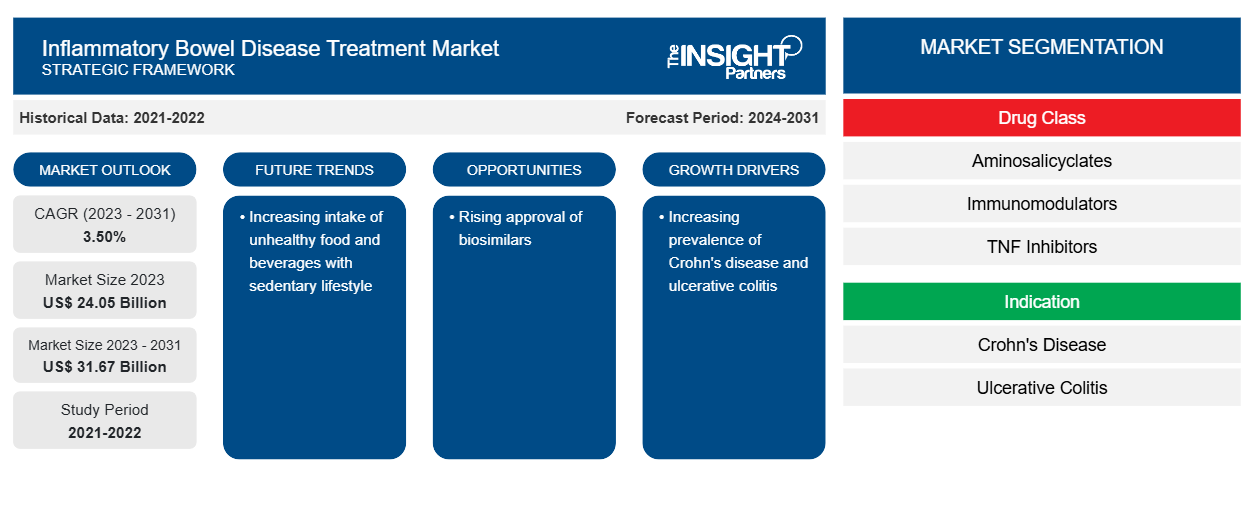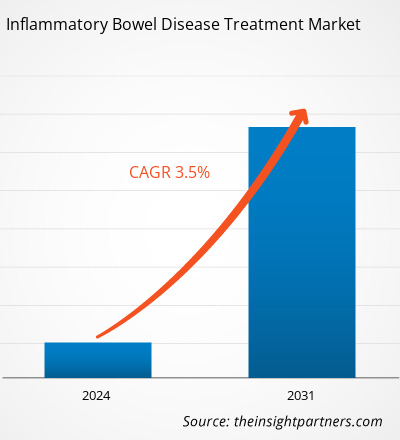Se proyecta que el valor del mercado del tratamiento de la enfermedad inflamatoria intestinal crecerá de US$ 24.05 mil millones en 2023 a US$ 31.67 mil millones en 2031; se anticipa que el mercado registrará una CAGR del 3,50% entre 2023 y 2031.
Perspectivas del mercado y opinión de analistas:
La enfermedad inflamatoria intestinal (EII) es una afección inflamatoria crónica del tracto gastrointestinal, que incluye la enfermedad de Crohn y la colitis ulcerosa. Estas afecciones provocan la inflamación del revestimiento del tracto digestivo, lo que provoca síntomas como dolor abdominal, diarrea, fatiga y pérdida de peso. El tratamiento tiene como objetivo reducir la inflamación, controlar los síntomas y prevenir complicaciones mediante medicamentos, cambios en el estilo de vida y, a veces, cirugía. El manejo de la EII generalmente requiere atención médica y monitoreo continuos para mantener la remisión y mejorar la calidad de vida. Los factores clave que impulsan el crecimiento del mercado de tratamiento de la enfermedad inflamatoria intestinal son la creciente prevalencia de la enfermedad de Crohn y la colitis ulcerosa, y el creciente número de lanzamientos de productos. Este informe incluye perspectivas de crecimiento debido a las tendencias actuales del mercado de tratamiento de la enfermedad inflamatoria intestinal y su impacto previsible durante el período de pronóstico. Es probable que los avances tecnológicos generen tendencias significativas en el mercado de tratamiento de la enfermedad inflamatoria intestinal en los próximos años. Además, también se espera que el desarrollo de tratamientos innovadores a través de la investigación continua, así como el fomento de iniciativas gubernamentales, impulsen el crecimiento del mercado.
Factores impulsores del crecimiento y desafíos:
La enfermedad de Crohn es un trastorno crónico y complejo que afecta principalmente al sistema digestivo. La Biblioteca Nacional de Medicina afirmó que hubo 825 casos de EII por cada 100.000 personas en 2023, en comparación con 410 casos de enfermedad de Crohn y 414 casos de colitis ulcerosa y EII-u. Con una prevalencia del 0,82%, 322.600 canadienses padecían EII en 2023. Los pacientes con enfermedades gastrointestinales tienen un mayor riesgo de deterioro nutricional debido a los requisitos de ayuno de las pruebas de diagnóstico, las restricciones dietéticas terapéuticas y la pérdida de apetito debido a la anorexia o los requisitos nutricionales alterados causados por la propia enfermedad. Por lo tanto, la nutrición enteral se prescribe a los pacientes con enfermedades gastrointestinales, ya que se prefiere la vía enteral para proporcionar los nutrientes necesarios. Por lo tanto, la creciente prevalencia de la enfermedad de Crohn y la colitis ulcerosa impulsa el crecimiento del mercado de tratamiento de la enfermedad inflamatoria intestinal.
La enfermedad de Crohn, las enfermedades gastrointestinales debidas a traumatismos, la obstrucción intestinal, la colitis microscópica, el síndrome del intestino corto y la colitis ulcerosa son algunas de las enfermedades gastrointestinales más comunes. Según un artículo publicado en Healthline en 2021, aproximadamente el 40 % de las personas en todo el mundo se vieron afectadas por trastornos gastrointestinales funcionales. La Fundación Canadiense para la Salud Digestiva afirma que millones de canadienses viven con enfermedades digestivas; aproximadamente 20 millones de canadienses, es decir, 2 de cada 3 personas, padecen trastornos digestivos cada año.
Por otra parte, el alto costo asociado con el tratamiento de la enfermedad inflamatoria intestinal (EII) es una barrera importante en el mercado de tratamiento de la EII. Desde medicamentos costosos hasta hospitalizaciones y cirugías frecuentes, el manejo de la EII puede suponer una gran carga financiera para los pacientes y los sistemas de atención médica. El factor costo a menudo limita el acceso a una atención óptima y tratamientos innovadores para muchas personas que viven con EII. Abordar los problemas de asequibilidad y accesibilidad es crucial para mejorar los resultados y la calidad de vida de los pacientes afectados por esta enfermedad crónica. Por lo tanto, el alto costo asociado con el tratamiento obstaculiza el crecimiento del mercado de tratamiento de la enfermedad inflamatoria intestinal.
Personalice este informe según sus necesidades
Obtendrá personalización en cualquier informe, sin cargo, incluidas partes de este informe o análisis a nivel de país, paquete de datos de Excel, así como también grandes ofertas y descuentos para empresas emergentes y universidades.
- Obtenga las principales tendencias clave del mercado de este informe.Esta muestra GRATUITA incluirá análisis de datos, desde tendencias del mercado hasta estimaciones y pronósticos.
Segmentación y alcance del informe:
El análisis del mercado de tratamiento de la enfermedad inflamatoria intestinal se ha llevado a cabo considerando los siguientes segmentos: clase de fármaco, indicación de la enfermedad y canal de distribución. Según la geografía, el mercado de tratamiento de la enfermedad inflamatoria intestinal está segmentado en América del Norte (EE. UU., Canadá y México), Europa (Reino Unido, Alemania, Francia, Italia, España y resto de Europa), Asia Pacífico (China, Japón, India, Australia, Corea del Sur y resto de Asia Pacífico), Oriente Medio y África (EAU, Arabia Saudita, Sudáfrica y resto de Oriente Medio y África) y América del Sur y Central (Brasil, Argentina y resto de América del Sur y Central).
Análisis segmental:
Perspectivas basadas en la clase de fármacos
Según la clase de fármaco, el mercado se segmenta en productos biológicos, aminosaliciclatos, corticosteroides y otros. El segmento de productos biológicos tuvo la mayor participación de mercado en el tratamiento de la enfermedad inflamatoria intestinal en 2023, y se prevé que registre la CAGR más alta durante 2023-2031.
Perspectivas basadas en indicaciones de enfermedades
Según la indicación de la enfermedad, el mercado de tratamiento de la enfermedad inflamatoria intestinal se divide en enfermedad de Crohn y colitis ulcerosa. Se prevé que el segmento de la enfermedad de Crohn tenga una participación de mercado significativa para 2031.
Perspectivas basadas en indicaciones de enfermedades
Según el canal de distribución, el mercado se clasifica en farmacias hospitalarias, farmacias minoristas y farmacias en línea. Se prevé que el segmento de farmacias hospitalarias tenga una participación significativa en el mercado de tratamiento de enfermedades inflamatorias intestinales para 2031.
Perspectivas regionales del mercado de tratamiento de la enfermedad inflamatoria intestinal
Los analistas de Insight Partners explicaron en detalle las tendencias y los factores regionales que influyen en el mercado de tratamiento de enfermedades inflamatorias intestinales durante el período de pronóstico. Esta sección también analiza los segmentos y la geografía del mercado de tratamiento de enfermedades inflamatorias intestinales en América del Norte, Europa, Asia Pacífico, Oriente Medio y África, y América del Sur y Central.

- Obtenga datos regionales específicos para el mercado de tratamiento de la enfermedad inflamatoria intestinal
Alcance del informe de mercado sobre el tratamiento de la enfermedad inflamatoria intestinal
| Atributo del informe | Detalles |
|---|---|
| Tamaño del mercado en 2023 | US$ 24.05 mil millones |
| Tamaño del mercado en 2031 | US$ 31,67 mil millones |
| CAGR global (2023 - 2031) | 3,50% |
| Datos históricos | 2021-2022 |
| Período de pronóstico | 2024-2031 |
| Segmentos cubiertos | Por clase de fármaco
|
| Regiones y países cubiertos | América del norte
|
| Líderes del mercado y perfiles de empresas clave |
|
Densidad de actores del mercado de tratamiento de la enfermedad inflamatoria intestinal: comprensión de su impacto en la dinámica empresarial
El mercado de tratamiento de la enfermedad inflamatoria intestinal está creciendo rápidamente, impulsado por la creciente demanda de los usuarios finales debido a factores como la evolución de las preferencias de los consumidores, los avances tecnológicos y una mayor conciencia de los beneficios del producto. A medida que aumenta la demanda, las empresas amplían sus ofertas, innovan para satisfacer las necesidades de los consumidores y aprovechan las tendencias emergentes, lo que impulsa aún más el crecimiento del mercado.
La densidad de actores del mercado se refiere a la distribución de las empresas o firmas que operan dentro de un mercado o industria en particular. Indica cuántos competidores (actores del mercado) están presentes en un espacio de mercado determinado en relación con su tamaño o valor total de mercado.
Las principales empresas que operan en el mercado del tratamiento de la enfermedad inflamatoria intestinal son:
- Pfizer, Inc.,
- Novartis AG,
- AbbVie, Inc.,
- Productos farmacéuticos Takeda, Johnson y Johnson
- , Corporación Celegene,
- Empresas de salud de Bausch
Descargo de responsabilidad : Las empresas enumeradas anteriormente no están clasificadas en ningún orden particular.

- Obtenga una descripción general de los principales actores clave del mercado de tratamiento de la enfermedad inflamatoria intestinal
Análisis regional:
El alcance geográfico del informe de mercado de tratamiento de la enfermedad inflamatoria intestinal abarca América del Norte, Europa, Asia Pacífico, Oriente Medio y África, y América del Sur y Central. En 2023, América del Norte tenía la mayor participación de mercado. Estados Unidos domina el mercado en América del Norte con la mayor participación en los ingresos. El tamaño en expansión del mercado de tratamiento de la enfermedad inflamatoria intestinal en este país se atribuye a un aumento en la prevalencia de enfermedades inflamatorias, la presencia de los principales actores del mercado y sus iniciativas estratégicas. Las soluciones de pago mejoradas, las altas tasas de tratamiento, el aumento de la prescripción de medicamentos innovadores, los esfuerzos de investigación ininterrumpidos y las iniciativas gubernamentales favorables también benefician al mercado de tratamiento de la enfermedad inflamatoria intestinal en los EE. UU. y otros países de América del Norte. Crohn's & Colitis Foundation es una de las organizaciones destacadas dedicadas a promover la investigación clínica y traslacional destinada a curar la colitis y la enfermedad de Crohn.
Panorama competitivo y empresas clave:
El pronóstico del mercado de tratamiento de la enfermedad inflamatoria intestinal presentado en este informe puede ayudar a las partes interesadas en este mercado a planificar sus estrategias de crecimiento. AbbVie Inc, Takeda Pharmaceutical Company Limited, Pfizer Inc, Biogen, Novartis AG, Lilly, UCB SA, CELLTRION INC., Merck & Co., Inc. y Johnson & Johnson Services, Inc. son algunas de las empresas clave que se describen en el informe del mercado de tratamiento de la enfermedad inflamatoria intestinal. Estas empresas se centran en ampliar sus ofertas para satisfacer la creciente demanda de los consumidores en todo el mundo. Su presencia global les permite atender a muchos clientes, lo que posteriormente les permite expandir su presencia en el mercado.
- Análisis histórico (2 años), año base, pronóstico (7 años) con CAGR
- Análisis PEST y FODA
- Tamaño del mercado Valor/volumen: global, regional, nacional
- Industria y panorama competitivo
- Conjunto de datos de Excel



Report Coverage
Revenue forecast, Company Analysis, Industry landscape, Growth factors, and Trends

Segment Covered
This text is related
to segments covered.

Regional Scope
North America, Europe, Asia Pacific, Middle East & Africa, South & Central America

Country Scope
This text is related
to country scope.
Preguntas frecuentes
Based on drug class, the market is segmented into biologics, aminosalicyclates, corticosteroids, and others. The biologics segment held the largest Inflammatory Bowel Disease Treatment Market share in 2023 and is anticipated to register the highest CAGR during 2023–2031.
Based on disease indication, the Inflammatory Bowel Disease Treatment Market is segmented into crohn's disease and ulcerative colitis. The crohn's disease segment is anticipated to hold a significant share by 2031.
The Inflammatory Bowel Disease Treatment Market was valued at US$ 24.05 billion in 2023.
The Inflammatory Bowel Disease Treatment Market is expected to be valued at US$ 31.67 billion in 2031.
The Inflammatory Bowel Disease Treatment Market has major market players, including AbbVie Inc, Takeda Pharmaceutical Company Limited, Pfizer Inc, Biogen, Novartis AG, Lilly, UCB S.A., CELLTRION INC., Merck & Co., Inc., and Johnson & Johnson Services, Inc.
The key factors driving the Inflammatory Bowel Disease Treatment Market growth are the rising prevalence of crohn's disease and ulcerative colitis and increasing product launches over the projection period. Inflammatory Bowel Disease Treatment Market trends include the technological advancement in IBD treatment. Furthermore, the development of innovative treatments through continuing research as well as encouraging government initiatives are also expected to fuel the market growth.
Inflammatory bowel disease" (IBD) is a chronic inflammatory condition of the gastrointestinal tract, including Crohn's disease and ulcerative colitis. These conditions cause inflammation of the digestive tract lining, leading to symptoms like abdominal pain, diarrhea, fatigue, and weight loss. Treatment aims to reduce inflammation, manage symptoms, and prevent complications through medication, lifestyle changes, and sometimes surgery. Managing IBD typically requires ongoing medical care and monitoring to maintain remission and improve quality of life.
Trends and growth analysis reports related to Life Sciences : READ MORE..
The List of Companies - Inflammatory Bowel Disease Treatment Market
- AbbVie Inc
- Takeda Pharmaceutical Company Limited
- Pfizer Inc
- Biogen
- Novartis AG
- Lilly
- UCB S.A.
- CELLTRION INC.
- Merck & Co., Inc.
- Johnson & Johnson Services, Inc.
- Mindray Medical International Limited
The Insight Partners performs research in 4 major stages: Data Collection & Secondary Research, Primary Research, Data Analysis and Data Triangulation & Final Review.
- Data Collection and Secondary Research:
As a market research and consulting firm operating from a decade, we have published and advised several client across the globe. First step for any study will start with an assessment of currently available data and insights from existing reports. Further, historical and current market information is collected from Investor Presentations, Annual Reports, SEC Filings, etc., and other information related to company’s performance and market positioning are gathered from Paid Databases (Factiva, Hoovers, and Reuters) and various other publications available in public domain.
Several associations trade associates, technical forums, institutes, societies and organization are accessed to gain technical as well as market related insights through their publications such as research papers, blogs and press releases related to the studies are referred to get cues about the market. Further, white papers, journals, magazines, and other news articles published in last 3 years are scrutinized and analyzed to understand the current market trends.
- Primary Research:
The primarily interview analysis comprise of data obtained from industry participants interview and answers to survey questions gathered by in-house primary team.
For primary research, interviews are conducted with industry experts/CEOs/Marketing Managers/VPs/Subject Matter Experts from both demand and supply side to get a 360-degree view of the market. The primary team conducts several interviews based on the complexity of the markets to understand the various market trends and dynamics which makes research more credible and precise.
A typical research interview fulfils the following functions:
- Provides first-hand information on the market size, market trends, growth trends, competitive landscape, and outlook
- Validates and strengthens in-house secondary research findings
- Develops the analysis team’s expertise and market understanding
Primary research involves email interactions and telephone interviews for each market, category, segment, and sub-segment across geographies. The participants who typically take part in such a process include, but are not limited to:
- Industry participants: VPs, business development managers, market intelligence managers and national sales managers
- Outside experts: Valuation experts, research analysts and key opinion leaders specializing in the electronics and semiconductor industry.
Below is the breakup of our primary respondents by company, designation, and region:

Once we receive the confirmation from primary research sources or primary respondents, we finalize the base year market estimation and forecast the data as per the macroeconomic and microeconomic factors assessed during data collection.
- Data Analysis:
Once data is validated through both secondary as well as primary respondents, we finalize the market estimations by hypothesis formulation and factor analysis at regional and country level.
- Macro-Economic Factor Analysis:
We analyse macroeconomic indicators such the gross domestic product (GDP), increase in the demand for goods and services across industries, technological advancement, regional economic growth, governmental policies, the influence of COVID-19, PEST analysis, and other aspects. This analysis aids in setting benchmarks for various nations/regions and approximating market splits. Additionally, the general trend of the aforementioned components aid in determining the market's development possibilities.
- Country Level Data:
Various factors that are especially aligned to the country are taken into account to determine the market size for a certain area and country, including the presence of vendors, such as headquarters and offices, the country's GDP, demand patterns, and industry growth. To comprehend the market dynamics for the nation, a number of growth variables, inhibitors, application areas, and current market trends are researched. The aforementioned elements aid in determining the country's overall market's growth potential.
- Company Profile:
The “Table of Contents” is formulated by listing and analyzing more than 25 - 30 companies operating in the market ecosystem across geographies. However, we profile only 10 companies as a standard practice in our syndicate reports. These 10 companies comprise leading, emerging, and regional players. Nonetheless, our analysis is not restricted to the 10 listed companies, we also analyze other companies present in the market to develop a holistic view and understand the prevailing trends. The “Company Profiles” section in the report covers key facts, business description, products & services, financial information, SWOT analysis, and key developments. The financial information presented is extracted from the annual reports and official documents of the publicly listed companies. Upon collecting the information for the sections of respective companies, we verify them via various primary sources and then compile the data in respective company profiles. The company level information helps us in deriving the base number as well as in forecasting the market size.
- Developing Base Number:
Aggregation of sales statistics (2020-2022) and macro-economic factor, and other secondary and primary research insights are utilized to arrive at base number and related market shares for 2022. The data gaps are identified in this step and relevant market data is analyzed, collected from paid primary interviews or databases. On finalizing the base year market size, forecasts are developed on the basis of macro-economic, industry and market growth factors and company level analysis.
- Data Triangulation and Final Review:
The market findings and base year market size calculations are validated from supply as well as demand side. Demand side validations are based on macro-economic factor analysis and benchmarks for respective regions and countries. In case of supply side validations, revenues of major companies are estimated (in case not available) based on industry benchmark, approximate number of employees, product portfolio, and primary interviews revenues are gathered. Further revenue from target product/service segment is assessed to avoid overshooting of market statistics. In case of heavy deviations between supply and demand side values, all thes steps are repeated to achieve synchronization.
We follow an iterative model, wherein we share our research findings with Subject Matter Experts (SME’s) and Key Opinion Leaders (KOLs) until consensus view of the market is not formulated – this model negates any drastic deviation in the opinions of experts. Only validated and universally acceptable research findings are quoted in our reports.
We have important check points that we use to validate our research findings – which we call – data triangulation, where we validate the information, we generate from secondary sources with primary interviews and then we re-validate with our internal data bases and Subject matter experts. This comprehensive model enables us to deliver high quality, reliable data in shortest possible time.


 Obtenga una muestra gratuita de este informe
Obtenga una muestra gratuita de este informe